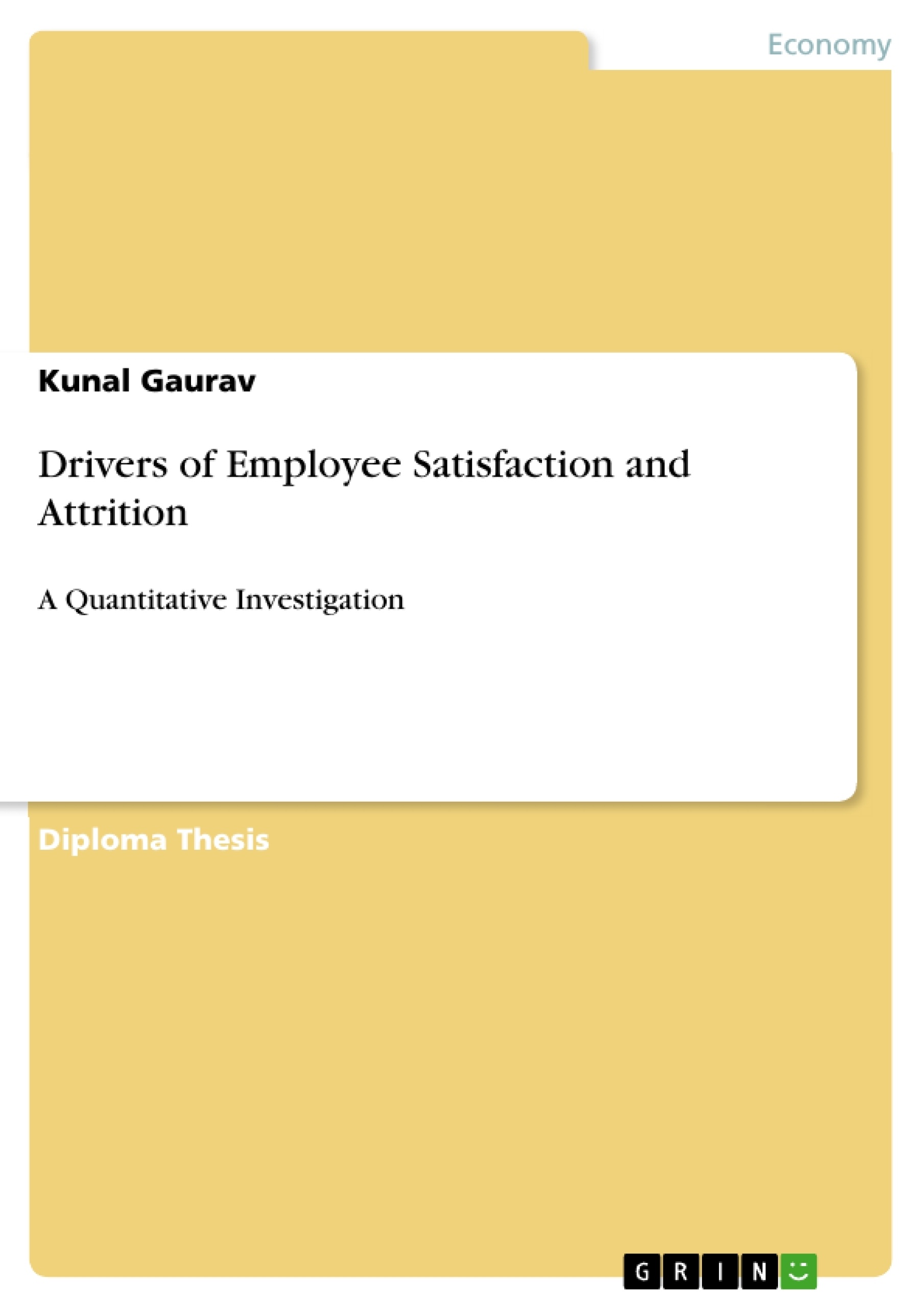In today’s competitive marketplace, businesses aiming for greater business success feel the importance of rethinking their functioning strategies to maximize the success potential. Employee satisfaction is given more importance in the rethinking process. Employee satisfaction is a very important ingredient for financial success of any business organization. By understanding the level of employee satisfaction, the company can have a better chance of delivering positive customer experiences, producing innovative products and services, and attaining a good bottom line.This study is aimed to understand importance of various factors that motivates employees to either continue with the existing employer or to look for a new position with another employer.
Inhaltsverzeichnis (Table of Contents)
- Introduction
- Need for the Study
Zielsetzung und Themenschwerpunkte (Objectives and Key Themes)
The objective of this study is to understand the factors that influence employee satisfaction and attrition. It aims to identify the drivers of employee satisfaction and the reasons behind employees leaving their jobs. This understanding is crucial for organizations to improve retention rates and boost overall productivity.
- Employee Satisfaction and its impact on organizational success
- Factors contributing to employee attrition
- The relationship between employee satisfaction and attrition
- Strategies for minimizing attrition and improving employee satisfaction
- The importance of understanding employee needs and motivations
Zusammenfassung der Kapitel (Chapter Summaries)
Introduction: This introductory chapter sets the stage by highlighting the increasing importance of employee retention in today's globalized business environment. It emphasizes the significant impact of attrition on organizations across industries, citing concerning attrition rates and the inadequacy of current salary growth plans. The chapter introduces the concept of employee satisfaction as a crucial element for organizational success, linking it to positive customer experiences, innovation, and profitability. It defines job satisfaction and attrition, contrasting the positive aspects of planned departures with the negative consequences of premature employee exits. The chapter concludes by stating the study's aim to understand the factors influencing employee decisions to stay or leave an organization.
Need for the Study: This chapter underscores the critical need for understanding the drivers of employee satisfaction and attrition. It highlights the value of human resources, especially in knowledge-worker organizations, and the negative impact of attrition, particularly the loss of key employees. The chapter contrasts the high attrition rates observed with limited understanding of the underlying causes among HR managers. It mentions common reasons for attrition, such as compensation inequity, limited career growth, and work stress, and suggests strategies for minimizing attrition, including offering opportunities for growth, reducing work stress, and providing job security. The chapter also advocates for conducting exit interviews to gain insights into employee departures. The overall argument centers on the urgent need for organizations to address these issues to improve employee satisfaction and retention.
Schlüsselwörter (Keywords)
Employee satisfaction, employee attrition, employee retention, job satisfaction, organizational success, human resources, compensation, career growth, work stress, exit interviews, productivity.
Frequently Asked Questions: Comprehensive Language Preview
What is the main objective of this study?
The study aims to understand the factors influencing employee satisfaction and attrition, identifying drivers of satisfaction and reasons for employees leaving their jobs. This understanding is crucial for improving retention rates and boosting productivity.
What are the key themes explored in this study?
Key themes include the impact of employee satisfaction on organizational success, factors contributing to employee attrition, the relationship between satisfaction and attrition, strategies for minimizing attrition and improving satisfaction, and the importance of understanding employee needs and motivations.
What does the introduction chapter cover?
The introduction highlights the growing importance of employee retention in today's business environment, emphasizing the negative impact of high attrition rates and the inadequacy of current salary-based retention strategies. It defines job satisfaction and attrition, linking employee satisfaction to organizational success, and states the study's aim to understand factors influencing employee decisions to stay or leave.
What is the focus of the "Need for the Study" chapter?
This chapter stresses the critical need to understand the drivers of employee satisfaction and attrition, highlighting the value of human resources and the negative consequences of losing employees, especially key personnel. It discusses common reasons for attrition (compensation inequity, limited career growth, work stress) and suggests strategies like offering growth opportunities, reducing stress, and providing job security, including conducting exit interviews to gain insights.
What are the key words associated with this study?
Key words include: Employee satisfaction, employee attrition, employee retention, job satisfaction, organizational success, human resources, compensation, career growth, work stress, exit interviews, and productivity.
What specific topics are covered in the Table of Contents?
The Table of Contents includes an Introduction and a section detailing the Need for the Study.
What is the overall goal of understanding employee satisfaction and attrition?
The ultimate goal is to enable organizations to improve employee retention rates and boost overall productivity by addressing the underlying causes of dissatisfaction and attrition.
What are some of the suggested strategies for minimizing attrition?
Suggested strategies include offering opportunities for career growth, reducing workplace stress, providing job security, and conducting exit interviews to gather valuable feedback from departing employees.
Why is understanding employee needs and motivations important?
Understanding employee needs and motivations is crucial for creating a more satisfying and productive work environment, leading to improved retention and organizational success.
What is the significance of the relationship between employee satisfaction and attrition?
The study explores the direct correlation between employee satisfaction and attrition, aiming to identify how improving satisfaction can directly reduce attrition rates.
- Quote paper
- Prof. Kunal Gaurav (Author), 2010, Drivers of Employee Satisfaction and Attrition, Munich, GRIN Verlag, https://www.grin.com/document/184601




